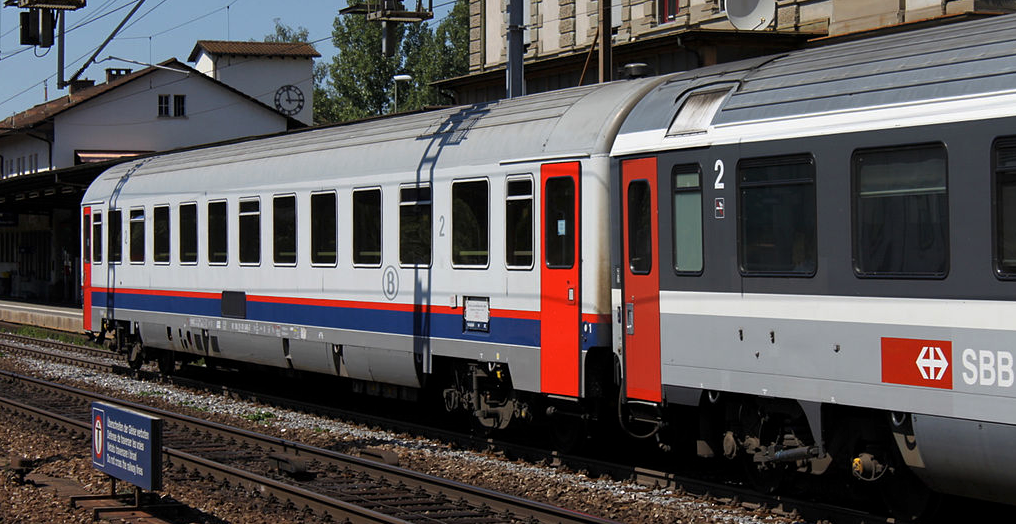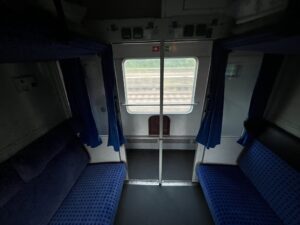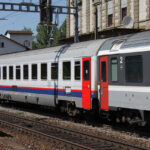In the draft European Parliament election programme of the German Grüne (full PDF here) you can find this paragraph about night trains (my translation):
Night trains are a comfortable and climate-friendly way to travel long distances within Europe and thus a good alternative to flying. A massive expansion of night train traffic is therefore necessary. We therefore advocate reduced track access charges, better support for cross-border trains, the rapid expansion of the railway infrastructure and, in particular, an industrial policy offensive for modern sleeping cars.
Similar to my earlier post about booking platforms, and how to turn the Grüne’s vision into reality, here I am going to explain how to actually do what this paragraph advocates.
I have written more about the case for night trains here, but despite the hype about their renaissance, development of a better night train offer in Europe is only advancing very slowly.
The problem starts with the lack of available night train carriages.
Only ÖBB and Trenitalia have ordered any new night train carriages in recent years. The first of the 33 new 7-carriage trains (so 231 carriages total) ÖBB has ordered from Siemens will begin commercial service in December this year, and the date for the entry into service of the at least 70 and possibly as many as 370 carriages Trenitalia has ordered from Škoda and Titagarh-Firema is unknown – the contract was only agreed a few months ago.
We cannot simply wait for either ÖBB or Trenitalia to solve the Europe-wide night train rolling stock problem for us – ÖBB has no intention to open maintenance workshops outside Austria, and all its carriages return to Austria after 4 nights running for service. Trenitalia’s focus is even more narrow – its focus is first and foremost on routes from the north to south of Italy.
Other firms that would like to enter the night train market are struggling with this rolling stock problem. The private operator European Sleeper has managed to cobble together enough carriages for a train every other night between Berlin and Brussels via Amsterdam – with a sleeping car from the 1950s and couchettes from the 1970s. Nothing better is available to lease. Midnight Trains has stated it will aim to purchase new carriages, but nothing has materialised. Sweden’s state agency Trafikverket had to abandon plans for a Malmö-Bruxelles night train as no company had any carriages to run the service.
So the core question is how to get more new night train carriages ordered?
The EU answer to this problem was to setup the Green Rail Investment Platform of the European Investment Bank in December 2021. Yet so far no orders for night train carriages have been forthcoming financed that way.
That leads me to the conclusion that two more radical solutions should be considered.

In the 1970s 500 so-called “Eurofima carriages” of a standardised design were ordered by a consortium of DB, ÖBB, FS, SNCB, CFF and SNCF. The advantage was a large order for a standardised carriage reduced the costs per unit, and made international operation simpler. So could the European Union have a go at coordinating a similar consortium of railway companies – both public and private – to make a similar order of night train carriages? How it could work is explained in more detail here.
An alternative would be to create a publicly-owned rolling stock pool. This idea is explained in more depth here, but the crux is that it is a public entity (a state (like Sweden) or a region (like Baden-Württemberg)) that makes the rolling stock investment, and then leases the carriages to operators. The European Union has never done this, but if nothing else is working as a means to make an order for new carriages, this ought to be considered.

The criticism from operators could well be that either of these options would end up with a standardised fleet of carriages, not altogether customised to their needs. But I reject that argument – given European Sleeper is managing to make a service run with night train carriages from the 1950s, a standardised modern design would be one hell of an upgrade.
Some night train advocates disagree with this attention to the rolling stock – and focus instead on the fragile financial framework for night trains, notably track access charges and the lack of public subsidy for night trains.
However as I see it the existence of the European Sleeper service, and SJ and Snälltåget’s Stockholm-Berlin night trains, shows that these issues are at least partially surmountable, and operating in places with subsidy (Sweden) and without (Germany) can be made to work.
The acquisition of the right new night train carriages would also be crucial here. A design that is deployable on every standard gauge track in Europe could then be used where the economic conditions for the development of a night train service were most favourable (or the subsidy the most generous). Designing 200km/h carriages – adequately fast for most night train routes – that are interoperable is eminently possible, and there are plenty of manufacturers in Europe who can build them.
There is also a crucial question of what has to happen in what order – the order for a fleet of carriages now would only see them running five years from now, leaving time to work on the track access and subsidy regimes in the time in between.
So if you want more night trains Europe-wide, you need more night train carriages. And there are some different options as to how to get them. Getting those carriages ordered – and a large order as soon as possible – is the central issue for the development of larger network of night trains, and must be the political imperative right now.
Creative Commons Licensed Images used in this post
 SNCB/NMBS Bm 61 88 21-70 645-3 in the consist of InterRegio 91 “Vauban” from Bruxelles-Midi to Chur at Liestal train station.
SNCB/NMBS Bm 61 88 21-70 645-3 in the consist of InterRegio 91 “Vauban” from Bruxelles-Midi to Chur at Liestal train station.
1 August 2009, 14:59:06
By NAC
CC BY-SA 4.0














Hi Jon,
I think we are more in the egg and chicken problem. Most “ex-national” companies are not “honestly” interested in night trains. They look at politicians talking about night trains with fear. OBB (and perhaps Trenitalia) are the real exceptions, but most others are not truly active in re-instating the night trains.
Worse, they are afraid to see private services (old problem) on “their” tracks. And not ready to share their remaining cars. Even the slots given to European Sleaper is crappy (coonstantly diverted also).
So, how can we talk about services when we can clearly see that there is no real decision to even create a basic network (a quick look at the past shows how ridiculous the current offer is). For me it has to start by forcing a minimum of X relations in EU .
Then we can discuss your ideas (they are great). Remember that for the Eurofima, in those days, they were demanding for modern cars.
And while waiting for new cars, some ex-national workshops are renovating cars at a high rate for their internal services mostly, some have one car coming out of workshops every 2 or 3 days. If you mix the information about those Eurofima now getting to their end of life, and the renovation capacity, it would be possible to have a renovated fleet within a year while waiting for the new ones.
All this needs a real decision. A politician imposing a number of realtions . And then you’ll see that there are no real problems, we can find fleets, slots, and ine a longer term, cars. And of course in that case, sharing orders, fleets and why not, maintenance, would be an audacious solution…
Sure, I agree with all of that. BUT if there were a pool of night train carriages that were good enough, and at a low enough price, to lease, I wonder what operators you could attract. They might be private ones like European Sleeper with new routes, or they might be state ones convinced enough there is a market (some of the smaller ones like ČD, MÁV or DSB might be interested).
Pingback: Nightjet Launches New Insanely Expensive Ticket Prices
The very late innovation of the mini-cabin by ÖBB (which were designed by a private company on behalf of Deutsche Bahn) shows that public procurement will not necessarily lead to the best type of carriages to be bought. For example, I do not believe couchettes are something that still should be built.